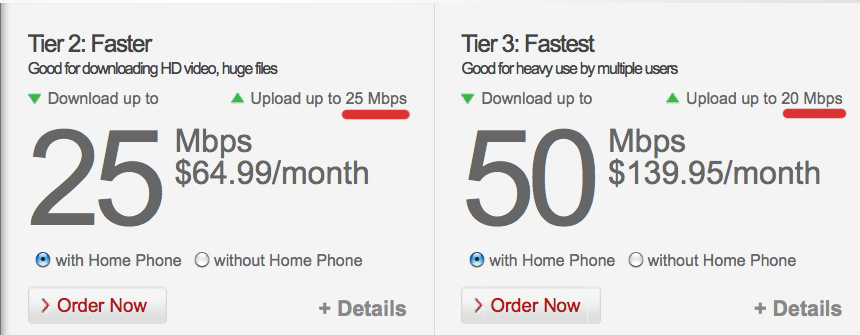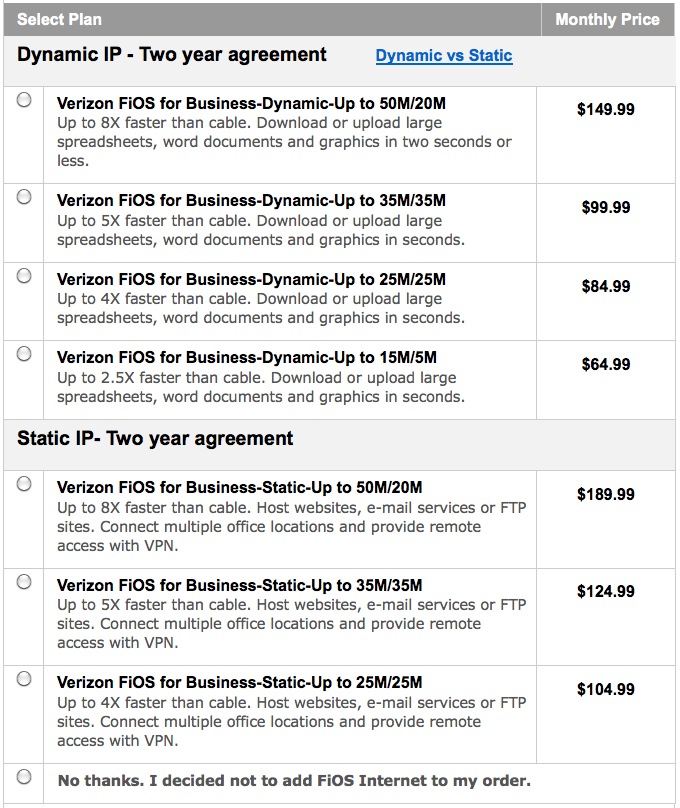If you want to get the most out of your Verizon FiOS (fiber to the home) Internet connection, here are your top two tiers:
I have the one on the left, and that’s what I’m paying for it. The service is rock-solid and reliable. So is support, as rarely as I’ve needed it.
But when I go to work, my upstream speeds are higher — up to 100 Mbps. I get more done. And I’m not the only techie who appreciates high upstream speeds. Boston is the world’s biggest college town, and full of other industries (pharma, big science, finance) that are staffed by professionals that could use the speed too.
But Verizon does this weird thing with the next tier up: they cut back the upstream speed from 25 Mbps to 20 Mbps. At double the price. WTF is that all about? When I ordered the 25 Mbps tier several months ago, the guy on the phone told me the reason was “just marketing.” He also said “We could give you 100Mbps tomorrow and blow everybody else out of the water.”
So why not?
Oddly, all of FiOS’ “Triple Play” (Internet + TV + phone) bundles here have relatively low Internet speeds, compared to the two tiers above. If the Net is your main interest, you might be better off without the TV and the phone. (In fact, we had the other two “plays” we got FiOS originally, and dumped them later, mostly because we hardly used them.) If you view more bundles, your best speeds are still just 25/25Mbps.
My request (and advice — and companies do pay me for this stuff) to Verizon is to do two things:
- Come up with a sensible offering — one that doesn’t subtract upstream value at twice the price.
- Try localizing a bit. Boston isn’t Red Bank. (And no offense to that town or other FiOS service areas.) See what happens when you super-serve a region with an offering that makes sense for it.
Maybe Verizon is doing that, sort of, with its business offerings. But getting to the actual offerings requires many clicks and filling out forms. Where I finally arrived in my latest hunt was a page with this set of choices:
First, this is much better than what I remember about my last look at FiOS business deals.
Second, that 35/35 offering is attractive.
Third, once again, we have an upstream speed drop when you go to the highest tier.
Fourth, the “static” offering is poorly explained. What this means is a real IP address, rather than one dynamically assigned by the router. This is real Internet stuff, so the customer can, say, run a server. (The copy does say “host websites.”) But, unless I’m missing it, nowhere does it say how many IP addresses the customer gets. For customers who care about this stuff, that’s the first question that will come up.
Fifth, the examples are poor. Here are some of the things that serious professional customers might care about:
- Offsite storage or backup
- Virtual computing in the cloud, such as with Amazon’s EC2
- Running servers in a co-lo or some other heavy-lifting environment
- Remote rendering, such as RenderCore
Verizon (or any ISP) could offer any of those services locally themselves, taking advantage of low latencies. In fact, in some cases that can be a huge advantage, and therefore a selling point.
Again, the service I’ve had all along with FiOS (going on three years now) has been solid and good — so good, in fact, that I miss it a lot when I’m gone. (Such as with this example here.) I just want it to be better. Hope this helps.


Leave a Reply